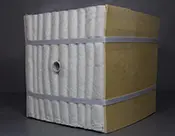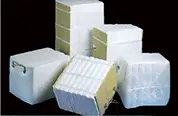
Insulation Cotton IntroductionInsulation cotton is a commonly used thermal insulation material, mainly used to reduce the transfer of heat and help maintain the
Insulation Cotton Introduction
Insulation cotton is a commonly used thermal insulation material, mainly used to reduce the transfer of heat and help maintain the temperature stability inside buildings or during the operation of equipment.
Insulation cotton can effectively reduce the conduction of heat through structural components such as walls, roofs, and floors, maintaining a stable indoor temperature, whether it is for keeping warm in winter or for heat insulation in summer.
By reducing heat loss, insulation cotton helps to reduce the load on heating and cooling equipment, thereby saving energy and reducing energy consumption costs.
In addition to its thermal insulation properties, insulation cotton also has a certain sound absorption function, which can reduce the intrusion of external noise and improve the quietness of the indoor environment.
Some types of insulation cotton have good moisture and waterproofing properties, which can prevent the accumulation of moisture and avoid the corrosion of building materials or the growth of mold caused by dampness.
Depending on the material, some insulation cotton has good fire resistance, which can delay the spread of fire and enhance the safety of buildings.
Insulation cotton is usually lightweight, easy to cut and install, and is suitable for the surfaces of various complex building structures, improving the construction efficiency.

Insulation cotton is widely used in residential buildings, commercial buildings, and industrial facilities, and it is of great significance for improving building energy efficiency and enhancing living comfort. Common insulation cotton materials include glass wool, rock wool, expanded polystyrene (EPS)/extruded polystyrene (XPS) foam boards, polyurethane foam, etc. When choosing a suitable type of insulation cotton, factors such as the specific application environment, the required thermal performance, and the budget need to be considered.
Thermal insulation
Energy saving
Sound insulation
Moisture and waterproofing
Fire resistance
Lightweight
Easy to construct
Chemical stability
Ceramic fiber cotton is a high-performance refractory material, characterized by its light weight, high temperature resistance (up to 1260°C to 1400°C or even higher), low thermal conductivity, and good chemical stability. It is widely used as a thermal insulation material in various industrial furnaces and high-temperature equipment.
Although the temperature resistance of glass wool is not as good as that of ceramic fiber cotton, it can still be used in some applications with lower temperatures. Its main advantages are low cost and easy installation. However, its working temperature range is usually between 300°C and 500°C, depending on the specific product.
These materials are particularly suitable for applications in extremely high-temperature environments, such as heating furnaces in certain special metallurgical processes. They can withstand very high temperatures and provide excellent thermal insulation effects.
Aluminum silicate cotton is also a common refractory and thermal insulation material that can work effectively within the temperature range of 900°C to 1200°C. It is known for its excellent heat resistance, light weight, and high-efficiency thermal insulation ability. The choice of which type of cotton depends on factors such as the specific working temperature of the heating furnace, the application scenario, and the budget. In practical applications, the most suitable product should be determined according to the technical parameters provided by the manufacturer. Due to their different chemical compositions and physical structures, cotton materials of different types have significant differences in thermal insulation effects, heat resistance, and other properties.
Ceramic fiber cotton: Ceramic fiber cotton has a very low thermal conductivity and can maintain good thermal insulation performance under extremely high temperatures (up to 1260°C to 1400°C or even higher). Its light weight and high-efficiency thermal insulation ability make it an ideal choice for industrial heating furnaces and other environments that require high-efficiency thermal insulation.
Glass wool: Glass wool is a widely used thermal insulation material, and its working temperature range is usually between 300°C and 500°C, depending on the product type. Although the thermal insulation performance of glass wool is not as good as that of ceramic fiber cotton, it has a lower cost, is easy to install, and performs well in medium and low-temperature applications.
Aluminum silicate cotton: Aluminum silicate cotton is also a commonly used thermal insulation material that can work effectively within the temperature range of 900°C to 1200°C. It is known for its excellent heat resistance, light weight, and high-efficiency thermal insulation ability, and is suitable for the thermal insulation layers of various high-temperature industrial equipment.
Rock wool: Rock wool not only has good thermal insulation performance but also excellent fire resistance and can be used at temperatures up to 600°C. In addition, rock wool also has a good sound absorption effect and is suitable for the thermal insulation and sound insulation needs of building exterior walls, roofs, and industrial pipelines.
Polyester fiber cotton: This type of cotton is mainly used as a filler in clothing and home decorations. Although it has a certain warming effect, it is not suitable for thermal insulation applications in high-temperature environments. Its main advantages lie in its softness and comfort.
Overall, for the thermal insulation needs in high-temperature environments, ceramic fiber cotton and aluminum silicate cotton are better choices, as they can provide more efficient thermal insulation protection. In medium and low-temperature environments, glass wool and rock wool can provide cost-effective solutions. The selection of each material should be based on specific application scenarios, the required working temperature range, the budget, and other specific requirements.
Please feel free to leave a message. We will reply you in 24 hours.
BAI KA Copyright © 2025 ALL rights reserved